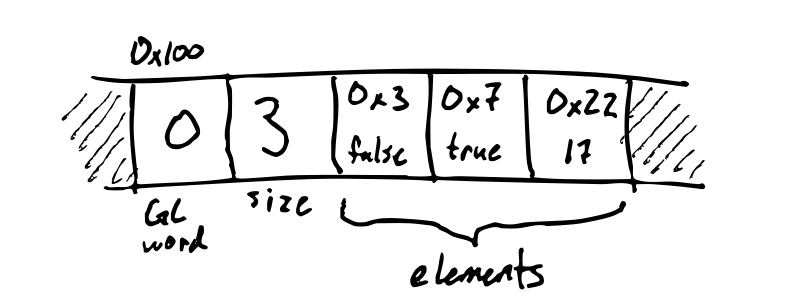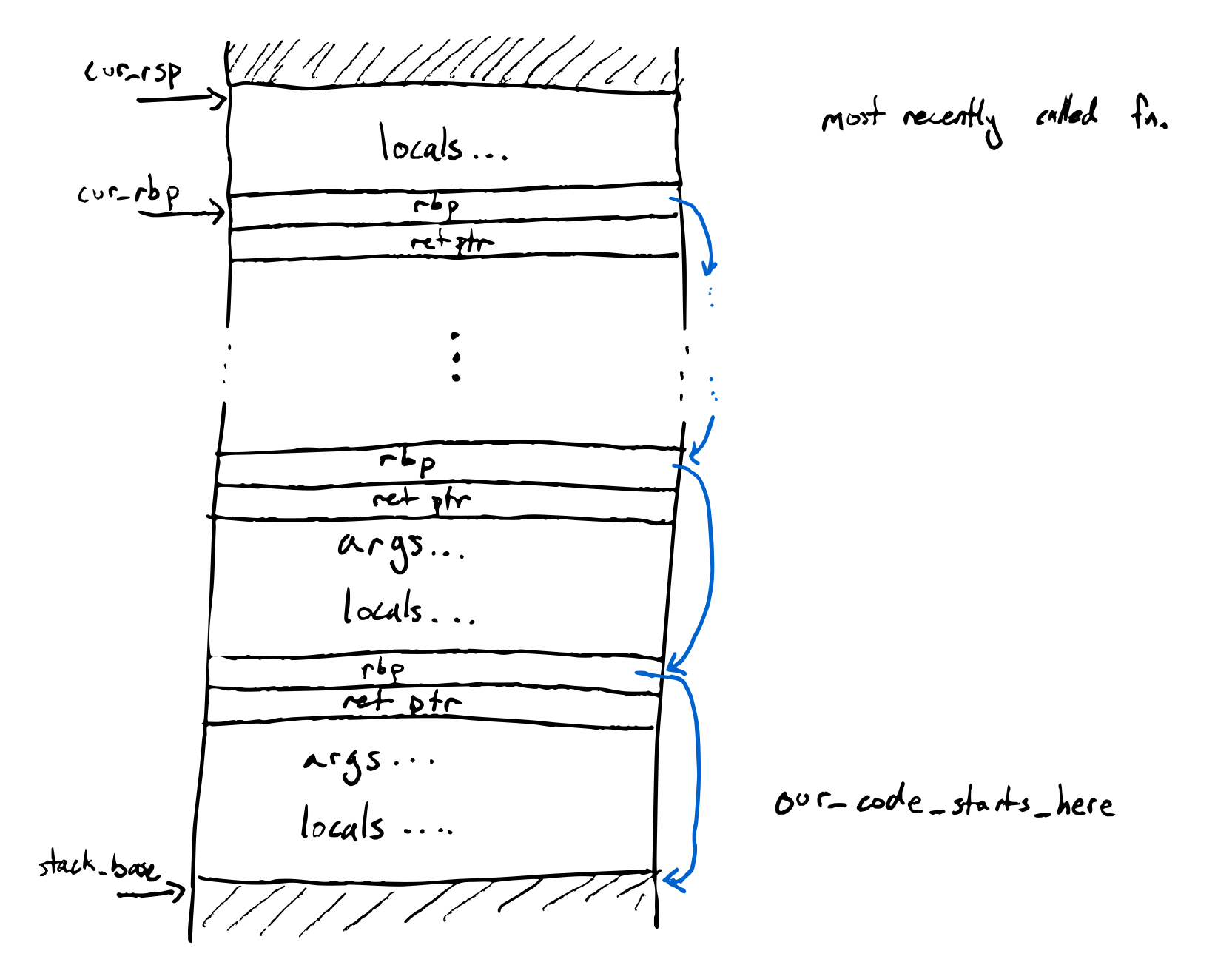
Week 8-9: Forest Flame, Due Thursday, June 1st (Closed Collaboration)
In this assignment you'll implement garbage collection for a language called Forest Flame, which uses our design for heap allocation.
Setup
For this assignment, you will (as in previous assignments) submit both a compiler and a runtime.
Since garbage collection is a runtime feature, we provide a working Forest Flame compiler for you: (github classroom, public starter code). If you use the starter code, you'll only have to modify the runtime. However, feel free to instead update your own Egg-Eater compiler to match the Forest Flame spec.
If you are participating in the Rust error study, please make sure you have the
build.rs and config.txt files in the new repository and set a new project
value in config.txt if you are using the starter code.
The Forest Flame Language
The Forest Flame language extends Diamondback with heap allocation and garbage collection.
Concrete Syntax
<prog> := <defn>* <expr>
<defn> := (fun (<name> <name>*) <expr>)
<expr> :=
| <number>
| true
| false
| nil
| input
| <identifier>
| (let (<binding>+) <expr>)
| (<op1> <expr>)
| (<op2> <expr> <expr>)
| (set! <name> <expr>)
| (if <expr> <expr> <expr>)
| (block <expr>+)
| (loop <expr>)
| (break <expr>)
| (gc)
| (vec <expr>*)
| (make-vec <expr> <expr>)
| (vec-get <expr> <expr>)
| (vec-set! <expr> <expr> <expr>)
| (vec-len <expr>)
| (<name> <expr>*)
optionally:
| (snek-<name> <expr>*)
<op1> := add1 | sub1 | isnum | isbool | isvec | print
<op2> := + | - | * | / | < | > | >= | <= | =
<binding> := (<identifier> <expr>)
The new pieces of syntax are nil, gc, vec, make-vec, vec-get,
vec-set!, vec-len, isvec, and / (division).
Additionally, it allows for any implementation-defined extra operations that
start with snek-,
which compilers for Forest Flame may implement or not as they like.
The starter code implements a (snek-printstack) operation.
Semantics
Forest Flame adds the runtime type of vectors.
A vector is either nil or a heap-allocated list of zero or more elements.
It adds these new syntax constructs:
-
nilevaluates to thenilvector. -
(gc)forces the garbage collector to run, and returns 0. -
(vec arg1 ... argN)allocates a new vector on the heap of sizeNwith contents[arg1, ..., argN]. -
(make-vec count value)allocates a new vector on the heap of sizecountwith contents[value, value, value, ...].It gives a runtime error if
countdoes not evaluate to a number, or if it evaluates to a negative number. -
(vec-get vec index)gets theindexth component ofvec.It gives a runtime error if
vecdoes not evaluate to a non-nil vector or ifindexdoes not evaluate to a valid (0-based) index into the vector. -
(vec-set! vec index value)sets theindexth component ofvectovalueand returnsvec.It gives a runtime error if
vecdoes not evaluate to a non-nil vector or ifindexdoes not evaluate to a valid (0-based) index into the vector. -
(vec-len vec)returns number of items ofvec.It gives a runtime error if
vecdoes not evaluate to a non-nil vector. -
(isvec value)returnstrueifvalueis a vector (possibly nil) andfalseotherwise. -
(/ x y)implements division and gives a runtime error if the denominatoryis zero. -
(snek-<name> args...): the specification and behavior of operations beginning withsnek-is implementation-defined. This means compilers can do whatever they want with these operations.The motivation is to make debugging your GC easier: feel free to add whatever built-in debugging operations would be helpful. For example, the starter code compiler implements a
(snek-printstack)operation. -
=should implement reference equality for vectors. -
Vectors are printed as comma-separated lists surrounded by square brackets,
nilis printed asnil, and cyclic references should be printed as[...].For example, the cyclic linked list containing
trueandnilwould be printed as[true, [nil, [...]]].
In addition, the compiled program now takes two arguments instead of just one.
-
The first argument is the input, which may be
true,false, or a number. If no arguments are provided, the default input isfalse. -
The second argument is the heap size in (8-byte) words, which must be a nonnegative number. If no second argument is provided, the default heap size is 10000.
During a program's execution, if heap space runs out, it runs the garbage
collector. If there is still not enough heap space, it exits with the error out of memory.
Examples
This program implements several linked list manipluations, which involve
allocating a lot of data which eventually becomes garbage.
It prints out "1\n2\n3\n4\n5\n5\n4\n3\n2\n1".
(fun (range n m)
(if (= n m) (vec n nil) (vec n (range (add1 n) m))))
(fun (append list1 list2)
(if (= list1 nil)
list2
(vec (vec-get list1 0) (append (vec-get list1 1) list2))))
(fun (reverse list)
(if (= list nil) nil (append (reverse (vec-get list 1)) (vec (vec-get list 0) nil))))
(fun (printall list) (loop
(if (= list nil) (break nil) (block
(print (vec-get list 0))
(set! list (vec-get list 1))
))))
(let ((list (range 1 5)))
(printall (append list (reverse list))))
See also the other examples in the tests/ directory of the starter code.
Garbage collection
You will edit runtime/start.rs to implement a mark-compact garbage collector,
as described in lecture.
Object layout
A Forest Flame heap object has two metadata words, followed by the actual data.
- First, there is a GC word, used to store the mark bit and the forwarding
pointer during garbage collection. Outside of garbage collection, the GC word
is always
0. - Next, there is a word which stores the length of the vector. (Note that a
vector of length
lenactually useslen + 2words, from the metadata.) - Next, there is each element of the vector, in order.
For example, the data (vec false true 17) stored at heap address 0x100 would
be represented by the value 0x101 and this heap data:

As a running example, consider this program, run with a heap size of 15 words:
(let ((x (vec false true 17))
(y (vec 1 2)))
(block
(set! x (vec nil y nil))
(set! y nil)
(gc)))
At the start of collection, the heap looks like this:

The stack contains the variables x and y. x has value 0x149 = C and
y is nil, so the root set is {C}.
Marking
The first step of mark-compact is marking. We mark a heap object by setting its mark bit, the lowest bit of the GC word. Marking does a graph traversal of the heap, starting from the roots found on the stack.
Here's what the heap looks like after marking:

Since object A is not marked, we know that it's dead and we can safely remove it from the heap.
Compacting
The second step of mark-compact is compacting. Compacting has three parts:
- Computing forwarding locations
- Updating references
- Moving objects
Compacting 1: compute forwarding addresses
Once marking is finished, we now know which objects are still alive and which are garbage based on whether the mark bit is set in the GC header. Objects which are still alive get forwarding addresses: this is its new address that it will be moved to after compacting. Computing forwarding addresses is done by a linear scan though the heap. Here's what the heap looks like afterwards:

Compacting 2: update references
In order to move an object, we also have to update all references to that object to point to the new location. We do this by a linear scan though both the heap and the stack, changing each vector to point to the vector's eventual new location. Here's what the heap looks like afterwards:

Note that the heap address stored in object C has been changed, and on the
stack, the stack slot storing the variable x has been updated to 0x121.
Compacting 3: move the objects
Lastly, we do the actual compacting, moving heap objects to their destinations. This is also a linear scan through the heap. Here's the final result:

Starter code
The starter code contains the function headers for snek_try_gc and snek_gc
which need to be implemented. snek_gc is called by the (gc) operation, and
snek_try_gc is called when there is not enough room for an allocation.
Heap layout
The static mut Rust variable HEAP_START has the address of the start of
the heap, and HEAP_END has the address of the end of the heap. These are set
once in main when the heap is allocated, and should never change again
throughout the running of the program.
Like the lecture compiler, the starter code uses r15 as a heap pointer. It is
passed to the functions snek_gc and snek_try_gc as the argument heap_ptr.
The space between HEAP_START and heap_ptr is full of objects, and the space
between heap_ptr and HEAP_END is free.
Stack layout
Not everything on the stack is a snek value -- there's also return addresses and some saved registers in there. So, to traverse the stack, it helps to know the exact layout of what it looks like.
The starter code compiler uses a stack frame layout that'll be hopefully
familiar if you've talked about stack frames in other classes, by using rbp as
the frame pointer. This means that during a function's execution, rbp points
to the bottom of the current function's stack frame.
On function entry, the function:
- Pushes the old value of
rbp - Saves
rspinrbp - Subtracts an amount of words from
rspto make room for local variables
Then, on function exit, it:
- Moves
rspback to where it used to be - Restores the old value of
rbpby popping it
(These operations are so common that x86 even has special instructions for them!) Concretely, the stack ends up looking like this:

Submission, testing, and grading
Submit via Gradescope.
We will test that your compiler + runtime (a) works, (b) runs out of memory when it should, and (c) doesn't run out of memory when it shouldn't.
-
Your runtime should only allocate as many words of heap space as specified by the command-line argument.
-
Your runtime needs to be able to use the whole heap (so you're more or less forced to use mark/compact)
-
Data on the heap is live if it is reachable from some variable or some currently-in-use temporary storage. (This is exactly the data kept after a GC.)
-
If, during an allocation,
(total live data size) + (new object size)≤(total heap size), then the allocation should succeed. Otherwise, it should halt with the messageout of memory. By “during an allocation”, we mean:- In a
make-vecexpression after the value and size subexpressions have been evaluated - In a
vecexpression after the element expressions have been evaluated
(This is relevant because it specifies that an expression like
(vec (+ nil 9))could never trigger out-of-memory, it would only error because of the runtime tag check on+. We aren't actively trying to test for these kinds of specific cases, but it helps to disambiguate.) - In a
This assignment is officially closed to collaboration, but we have some specific categories where we encourage you to share:
- You may share test cases with your peers by submitting them to the [student test repo] below. Have test cases case you think will break your classmates' GCs? Test cases that helped you fix a bug? Cool programs you just want to share? Make a PR! We'll merge in the pull requests every day or two.
- You may share (publicly on EdStem or otherwise) diagrams or other representations of the heap + stack at various stages in garbage collection to understand examples
Student Test Repo: https://github.com/ucsd-compilers-s23/forest-flame-student-tests
Extension: simple generational GC
As discussed in lecture, nearly all modern garbage collectors take advantage of the high infant mortality rate for heap allocations, by segregating the heap into multiple generations, each of which stores data of a particular age, and processing the older generations less frequently than the younger generations.
In this extension, you'll implement this idea by adding a nursery to your GC.
- The nursery should be around 10% of the size of the old space (the main mark-compact heap).
- Allocations go into the nursery (i.e.,
r15points into here); when nursery space runs out, this triggers a minor collection. (Large objects which don't fit into the nursery should be allocated directly to the old space.) - A minor collection evacuates the nursery, reallocating all its live objects into the old space (using the copying GC algorithm). When main heap space runs out, this triggers a major collection.
- A major collection collects both the nursery and the old space, compacting both the old space and the nursery into the old space.
Write barriers and the remembered set. What root set do we use for a minor collection? Pointers into the nursery can come from two sources: the stack, or the old space. The stack is typically quite small, but we want to avoid traversing the whole old space -- after all, this is what makes a minor collection fast.
So in order to find roots from the old space, we'll make the program keep a log of which old-space objects contain pointers into the nursery. This has a runtime component and a compiler component:
- At run time, we need a physical datastructure (usually called the remembered set) to record which old-space objects may contain pointers into the nursery. A good option here is an array of pointers to old-space objects, together with a header flag in each old-space object saying whether it's already in the remembered set. When the array fills up, you could either resize it, or reset it by triggering a minor collection.
- Before writing to the heap in
vec-set!, we need to check if it's putting a pointer into the nursery into the old space, and if so, update the remembered set accordingly. This requires compiler support. (In general, any kind of GC-related check that happens during memory writes is called a write barrier.)